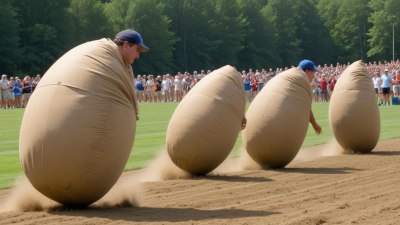Why You Only Realize the Field Slopes During Sack Races
Explore the surprising realization of field slopes during sack races and their effects on balance and competition.

This image was created with the assistance of Freepik
Sack races are a classic outdoor activity often enjoyed during picnics, community events, and school field days. They bring fun and laughter as participants hop in burlap sacks towards the finish line. However, one interesting phenomenon many participants experience is the sudden realization of the field's slopes when engaging in the race. This article delves into the reasons behind this observation and its implications on the dynamics of sack racing.
The Basics of Sack Races
Sack races generally involve competitors jumping in large sacks and racing towards a designated finish line. The simplicity of the game—with just bags and a starting line—makes it accessible for all ages. Participants often find themselves laughing, struggling to maintain balance while competing against friends and family. But, what happens when the ground isn't flat? This is where the nuances of the field's slopes come into play.
Understanding the Dynamics of Motion
When jumping in a sack, competitors experience an unusual form of locomotion. The bags restrict lower body movement, forcing participants to rely on balance and core strength. It is during this hopping motion that the perception of the ground drastically changes. Unlike running on stable terrain, the unevenness of a sloped field becomes palpable as any slight incline or decline affects balance and stability. Notably, the human body naturally compensates for changes in terrain when walking or running, but the added challenge of the sack makes it far more apparent.
Physical Forces at Play
Physics plays a considerable role in the experience. As participants hop down a slope, gravitational forces become a significant factor. Going downhill may initially seem easier, but it can quickly lead to a loss of control due to a higher speed of descent. Conversely, moving uphill requires increased effort, making it harder for participants to maintain their footing. The unique interaction between gravity and inclines thus heightens awareness of the terrain. The more one engages with the sack, the more the field's slopes become evident.
The Role of Focus and Awareness
During competition, racers are typically focused on the goal: finishing the race as quickly as possible. This eager mentality can cause participants to overlook subtle changes in the environment, including the distribution of the terrain. However, once in motion, attention sharpens. Every hop offers a fresh opportunity to assess the ground beneath—no longer just a rigid racecourse but a living landscape affecting performance. Consequently, racers develop an acute awareness of the slopes as they continuously adjust their movements, acknowledging how terrain intricacies impact their speed and balance.
The Mental Aspect of Racing
An essential aspect of sack racing is the mental game it incorporates. Participants must not only physicalize their awareness of slopes but also navigate their anxieties about losing balance and falling during the race. Friction with the ground alters significantly depending on the incline; on slopes, loose soil or uneven grass can lead to slips or trips. Hence, racers may unconsciously increase their vigilance concerning potential hazards, reinforcing their perception of slope dynamics. The embrace of mental focus complements physical adaptations, forming a bond between what one feels and what one thinks throughout the racing experience.
Designing the Ideal Course
Awareness of field slopes doesn't just affect individual racers; it has significant implications for event organizers. Designing a balanced sack race course requires careful planning. Ideally, organizers should seek to select venues that provide even terrain to minimize the surprises that could occur during competition. However, including slight slopes presents an exciting challenge, blending skill and strategy into the fun. Event coordinators might even introduce rules regarding the course's layout or advise contestants to be mindful of terrain changes, thereby fostering a deeper understanding of the field's characteristics and enhancing the overall race experience.
Teaching Moment: Learning Through Play
Sack races are not just simple competitions but also serve as an educational platform. Participants, especially children, can learn valuable lessons about balance, coordination, strategy, and decision-making as they maneuver through varying terrains. By understanding how slopes influence their behavior, they develop problem-solving skills that reach beyond the field. Facilitators can encourage discussions about terrain dynamics, physics lessons on gravity, and encouraging sportsmanship and teamwork. These moments of learning during playful activities leave a lasting impression on young minds, empowering them with knowledge that informs future sports encounters.
Adapting to Different Terrains
In real-world applications, the recognition of slopes during sack races can translate to broader outdoor activities and sports. For instance, preparing for running events in hilly areas or participating in other games that involve varying terrains becomes a practical exercise in adapting to one’s environment. Understanding how to approach hills while climbing or descending greatly improves overall performance—lessons learned during playful sack races reinforce these essential skills. Racers can learn to gauge their speed, footing, and agility in different environments, becoming versatile athletes.
Embracing the Hills
In conclusion, the seemingly simple act of hopping in a sack can unveil intricate relationships between our body dynamics, mental processes, and environmental conditions, particularly when faced with slopes. The heightened awareness of the field's topology not only enhances the competitive spirit but also enriches the overall experience. Ultimately, whether racing uphill or down, participants engage in a multifaceted journey that transcends the initial intent of merely winning. This interplay among physics, strategy, and fun firmly roots itself in the memories created on those sloped fields, leaving lasting impressions which encourage the continuation of playful competition.











